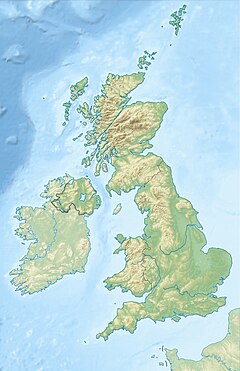Smalls Lighthouse

Smalls Lighthouse in 2009
|
|
|
United Kingdom
|
|
| Location | The Smalls off Marloes Peninsula Pembrokeshire Wales |
|---|---|
| Coordinates | 51°43′16″N 5°40′11″W / 51.721239°N 5.669831°WCoordinates: 51°43′16″N 5°40′11″W / 51.721239°N 5.669831°W |
| Year first constructed | 1776 (first) |
| Year first lit | 1861 (current) |
| Automated | 1987 |
| Construction | stone tower |
| Tower shape | tapered cylindrical tower with balcony, lantern and helipad on the top |
| Markings / pattern | unpainted tower |
| Height | 41 metres (135 ft) |
| Focal height | 36 metres (118 ft) |
| Current lens | 1st Order catadioptric |
| Light source | solar power |
| Intensity | 39,800 candela |
| Range | 18 nautical miles (33 km; 21 mi) |
| Characteristic | Fl (3) W 15s. (24h) |
| Admiralty number | A5278 |
| NGA number | 5600 |
| ARLHS number | WAL-023 |
| Managing agent |
Trinity House |
| Heritage |
Grade II listed building |
|
[]
|
|
Trinity House
Smalls Lighthouse stands on the largest of a group of wave-washed basalt and dolerite rocks known as The Smalls approximately 20 miles (32 km) west of Marloes Peninsula in Pembrokeshire, Wales, and 8 miles (13 km) west of Grassholm. It was erected in 1861 by engineer James Douglass to replace a previous lighthouse which had been erected in 1776 on the same rock. It is the most remote lighthouse operated by Trinity House.
The original Smalls Lighthouse was erected over 1775 and 1776, on the plans of Liverpool musical instrument maker Henry Whiteside. It stood on nine oak pillars, allowing the sea to pass through beneath. Although it suffered from some rocking, it stood for 80 years. During its life a significant number of extra struts were added beyond the original nine. The pillar-based design has since been used successfully in many sea structures.
The old lighthouse generated some fine stories. When Whiteside visited the lighthouse in 1777, he was stranded for a month by gales which showed no sign of abating so that supplies were almost exhausted. He wrote a message to a friend in St David's placed in a bottle inside a casket with a note to the finder "We doubt not but that whoever takes this up will be so merciful as to cause it to be sent to Thomas Williams, Esq, Trelithin, near St. David's, Wales". Two days later it arrived almost outside the door of the addressee to whom it was duly delivered.
More disturbingly, the old lighthouse brought about a change in lighthouse policy in 1801 after a gruesome episode. The two man team, Thomas Howell and Thomas Griffith, were known to quarrel, and so when Griffith died in a freak accident, Howell feared that he might be suspected of murder if he discarded the body into the sea. As the body began to decompose, Howell built a makeshift coffin for the corpse and lashed it to an outside shelf. Stiff winds blew the box apart, though, and the body's arm fell within view of the hut's window and caused the wind to catch it in such a way that it seemed as though it was beckoning. Working alone and with the decaying corpse of his former colleague outside Howell managed to keep the lamp lit. When Howell was finally relieved from the lighthouse the effect the situation had had on him was said to be so extreme that some of his friends did not recognise him. Until the automation of British lighthouses in the 1980s lighthouse teams were changed to rosters of three men. In 2011 (repeated 3 April 2014), the affair was the subject of a BBC radio play called "The Lighthouse" written by Alan Harris.. The 2016 film The Lighthouse directed by Chris Crow is based on the incident.
...
Wikipedia

